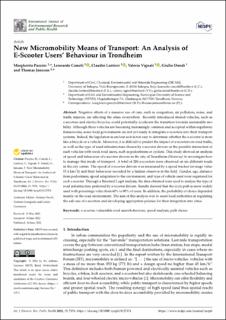| dc.description.abstract | Negative effects of a massive use of cars, such as congestion, air pollution, noise, and traffic injuries, are affecting the cities everywhere. Recently introduced shared vehicles, such as e-scooters and electric bicycles, could potentially accelerate the transition towards sustainable mobility. Although these vehicles are becoming increasingly common and accepted within regulatory frameworks, some local governments are not yet ready to integrate e-scooters into their transport systems. Indeed, the legislation is unclear as it is not easy to determine whether the e-scooter is more like a bicycle or a vehicle. Moreover, it is difficult to predict the impact of e-scooters on road traffic, as well as the type of road infrastructure chosen by e-scooter drivers or the possible interaction of such vehicles with weak road users, such as pedestrians or cyclists. This study showed an analysis of speed and behaviour of e-scooter drivers in the city of Trondheim (Norway) to investigate how to manage this mode of transport. A total of 204 e-scooters were observed on six different roads in the city centre. The speed of e-scooter drivers was measured by a speed tracker (average value 15.4 km/h) and their behaviour recorded by a hidden observer in the field. Gender, age, distance from pedestrians, speed adaptation to the environment, and type of vehicle used were registered for each e-scooter. Through a Binomial Logit analysis, the data obtained were used to analyse the type of road infrastructure preferred by e-scooter drivers. Results showed that the cycle path is more widely used with percentage value from 60% to 90% of users. In addition, the probability of choice depended mainly on the road environment. The aim of this analysis was to assist local authorities in regulating the safe use of e-scooters and developing appropriate policies for their integration into cities. | en_US |

